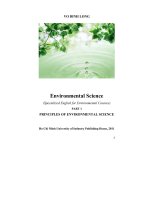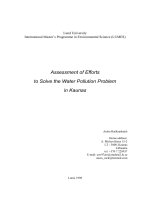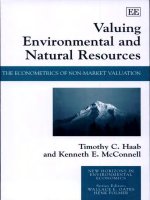Environmental Science: forest resources
Bạn đang xem bản rút gọn của tài liệu. Xem và tải ngay bản đầy đủ của tài liệu tại đây (2.62 MB, 43 trang )
Group 1
Forest Resources
Group’s Member:
1. Phạm Đức Tú (C)
2. Đặng Minh Sơn
3. Vũ Nguyễn Huy
4. Đinh Thị Hương
5. Nguyễn Vân Anh
6. Lê Nam Thành
7. Nguyễn Hoàng Long
Forest Resources
1. Overview of forest resources
2. The importance of forests for environment
3. Common causes of deforestation
4. Forest loss and management
5. The forest resources in Vietnam
6. Issues of exploitation and use forests in Vietnam
1. Overview of forest resources
Forest is one of the most important parts constituting the
biosphere.
It has an extremely important role in creating the
landscape and have a strong impact to the climate
factors, land
1. Overview of forest resources
Standpoint theory of ecosystems, the forest are seen as a
typical ecosystems in the biosphere (Temslay, 1935: Vili, 1957;
Odum, 1966).
On the other hand, Based on the theory of the forest of
Morodov Sukasov, the forest are a Biogeocenose.
Two theories are not different in the nature. They are
recognized and used in research of the forest
Forests are also of great significance in the development of
economic, social, ecological and environment
1. Overview of forest resources
The formation of forest types are closely related to the
formation of natural vegetation with geographical and
climatic conditions.
In each forest type is formed, the climate, soil, moisture
will determine the composition and structure of the
potential development of vegetation.
1. Overview of forest resources
The division of the forest types of forest vegetation types are mainly
based on the ecological advantages
Some flora is important in the world
• Temperate coniferous forests with a relatively homogenous, lower
yields than the tropics, they are mainly distributed in North America,
Europe, North China and some tropical mountains. The trees are
mainly pine, spruce, fir
1. Overview of forest resources
Temperate deciduous forest is distributed at low and tropical
regions, mainly in northeast America, South America, Asia
Europe, a part of China, Japan, Australia
1. Overview of forest resources
Tropical rain forests are distributed mainly in the equatorial
region of the Amazon Basin (South America), the Congo River
(Africa), India, Malaysia. Because of the complexity of
changing rainfall patterns, monsoon and temperature, the
tropical forest are often very complex in both composition and
structure of forest
1. Overview of forest resources
Based on the nature and purpose, the forest is divided into
three types
1. Protection forests are used for the purpose of protecting
water, soil, prevent erosion and mitigate natural disasters,
climate regulation, protection of ecological environment.
Protection forest divided into three types, watershed
protection forests, forest protection against sand and forest
protection of coastal waves
1. Overview of forest resources
2. Special use forests are used for special purposes such as
nature conservation, genetic conservation of forest flora and
fauna, in service of scientific research, protection of
historical, cultural and scenic for tourism. It includes national
parks, nature reserves, cultural and historical sites
1. Overview of forest resources
3. Production forests, including forest type used for wood
production, forest animals and associated ecological
environment protection.
1. Overview of forest resources
Forests is an important resource, forests provide raw
materials for human and base economic resources of many
ethnic in the world. Exploitation of forest resources has
contributed an important part in economic and social
development of many countries around the world.
Forest resources are plentiful and diverse, including
biological resources, land, climate and landscape.
The exploitation and utilization of forest resources in the
world depends on technology, traditions and social customs
of each region and each country.
2. The importance of forests for environment
Forests are the most important component constituting
Biosphere. In addition to significant plant and animal
resources , , the forest is also a geographical factor which is
essential in nature, it plays vitally important role in the
landscape and have strong impact to the land climate factors.
Therefore,it is not only has the function of forests in economic
development, social but also of special significance in
environmental protection .
2. The importance of forests for environment
1. Forests are the obstacles to the transport of wind and affect
speed and direction of wind. In general, if h is the height of
the forest range, the incidence of forests to reduce wind speed
significantly within 50-10 h in direct side and 20 - 30h in
indirect side.
2. The importance of forests for environment
2. Forest not only blocks wind but also cleans the air and have a great
influence on carbon cycle in nature.
3. Forests also contribute significantly reduces noise
For example a 50 m wide strip of trees beside the road has the
potential to reduce noise 20 -30 dB
4.Forest has special meaning to the importance of balance oxygen and
carbon dioxide in the atmosphere
2. The importance of forests for environment
Forest created a sub-climate environment well to human
health. Forests reduces the temperature and increases
humidity. Especially many species can secrete substances with
bactericidal action phitoxin special pine (Pinus sp), camphor
(camphora cinamonmun), eucalyptus (Eucalyptus), cinnamon
(cassia Cinnamonmun)
Forest with the role of watershed protection, soil protection
against erosion. Vegetation have an important function in
preventing a fall to the ground and rain water has a role in the
redistribution of this water.
3. Common causes of deforestation
Commercial logging companies cut down mature trees that
have been selected for their timber. The timber trade defends
itself by saying that this method of 'selective' logging ensures
that the forest regrows naturally and in time, is once again
ready for their 'safe' logging practices (WWF).
Removing a felled tree from the forest causes even further
destruction, especially when it is carried out carelessly. It is
believed that in many South East Asian countries 'between 4574% of trees remaining after logging have been substantially
damaged or destroyed
3. Common causes of deforestation
The reason these people are referred to as 'shifted' cultivators
is that most of them people have been forced off their own
land. For example, in Guatemala, rainforest land was cleared
for coffee and sugar plantations. The indigenous people had
their land stolen by government and corporations. They
became 'shifted cultivators', moving into rainforest areas of
which they had no previous knowledge in order to sustain
themselves and their families (Colchester & Lohmann)
3. Common causes of deforestation
The creation of national parks has undoubtedly helped to
protect rainforests. Yet, as national parks are open to the
public, tourism is damaging some of these areas.
Often, national parks are advertised to tourists before
adequate management plans have been developed and
implemented. Inadequate funding is allocated for preservation
of forests by government departments. Governments see
tourism as an easy way to make money, and therefore tourism
is encouraged whilst strict management strategies are given
far less government support.
4. Forest loss and management
Anthropogenic factors that can affect forests include
logging, urban sprawl, human-caused forest fires, acid
rain, invasive species, and the slash and burn practices
of swidden agriculture or shiftin cultivation.
Expand the area of agricultural land to meet food production
Demand for fuelwood
Grazing
4. Forest loss and management
The loss and re-growth of forest leads to a distinction between
two broad types of forest, primary or old-growth forest and
secondary forest. There are also many natural factors that can
cause changes in forests over time including forest fires
insects, diseases, weather, competition between species, etc.
In 1997, the World Resources Institute recorded that only 20%
of the world's original forests remained in large intact tracts of
undisturbed forest.More than 75% of these intact forests lie in
three countries - the Boreal forests of Russia and Canada and
the rainforest of Brazil .
5. The forest resources in Vietnam
Statistics in Vietnam show that 19.2 million hectares are forest land of
which 9.3 million hectares are forested area, and 10 million hectares are
denuded hillsides and barren lands.
Figures assumed to apply around 1995 (Editor).
Description
Total
Forested
Non-forested
Forest land
19.1
9.3
9.7
- Special-use forest
1.2
0.9
0.3
- Protection forest
8.0
3.5
4.5
- Production forest
9.9
4.9
5.0
5. The forest resources in Vietnam
Forest cover in various areas/regions of Vietnam
The differences in climatic conditions from sub-equatorial areas to sub-
tropical ones as noticed in Vietnam and its elevations from sea level to
mountains of over 3,000 m high, have caused the indigenous plant and
forest resources to differ in terms of tree composition, forest types and
forest cover
Region
%
Nation-wide
28
- North West
14
- Paper raw material area (in the North)
24
- North East
20
- Red River Delta
4
- North Central Vietnam
35
- Coastal South Central Vietnam
35
- Western High Plateaux
56
- East South Vietnam
21
- Mekong Delta
5
5. The forest resources in Vietnam
Changes in forest resources and prospects in the year 2010
Looking back to the year 1943, one can find that the forest cover at that
time was not less than 43%. Satellite imageries obtained in 1973 thaw that
the forest area amounted then to 9.5 million hectares, accounting for a
cover of 29%. Statistics from the years 1981 and 1982, gained through the
interpretation of photos from Landsat in 1979-1981 and from KATE 140
during the same period, show that the forested area was then 7.8 million
hectares covering 28% of total land. The forested area in 1995 and the
forest cover during the same year look almost the same as in 1989.









